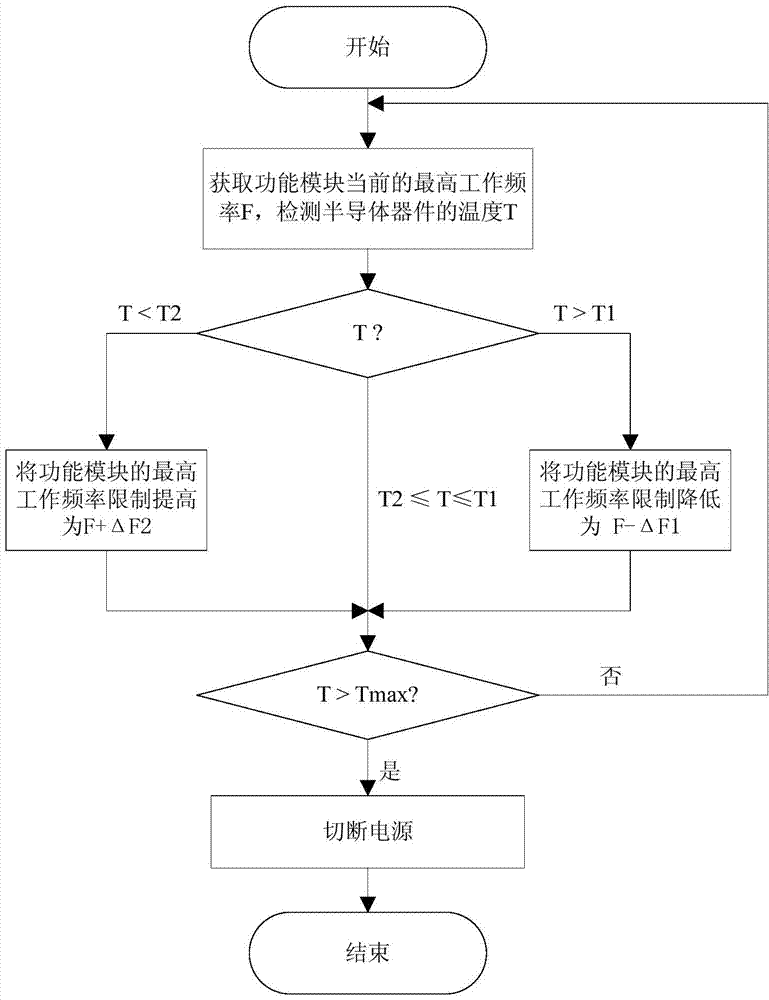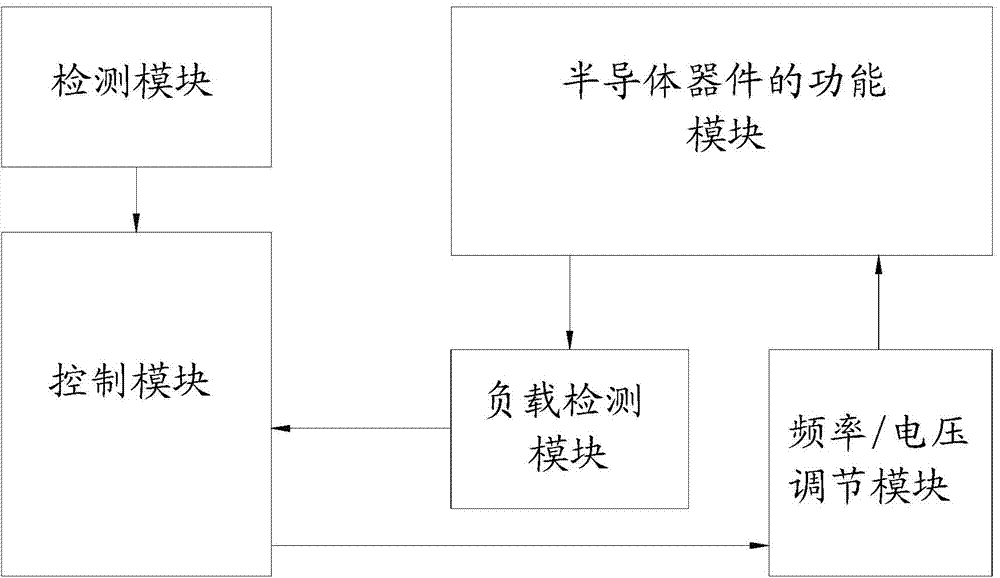Temperature control method for semiconductor device
A temperature control method and temperature control system technology, applied in the direction of temperature control using electric methods, can solve the problems of reducing the performance of semiconductor devices, poor adaptability, and low frequency, so as to prevent excessive temperature, improve adaptability, and reduce power. consumption effect
- Summary
- Abstract
- Description
- Claims
- Application Information
AI Technical Summary
Problems solved by technology
Method used
Image
Examples
specific Embodiment 1
[0048] Take the SOC system on chip (hereinafter referred to as SOC chip) as an example. The SOC chip contains a CPU function module. The maximum temperature allowed by the SOC chip is 100°C. The first temperature level is 85°C, and the second temperature level is 75°C. ℃.
[0049] The methods include:
[0050] Step 1, detect the temperature T of the SOC chip, and obtain the current highest operating frequency F of the CPU function module of the SOC chip (the present embodiment F gets 1200MHz);
[0051] Step 2, according to the temperature T of the detected SOC chip and the current maximum operating frequency F (the present embodiment F gets 1200MHz), dynamically adjust the maximum operating frequency limit of the CPU function module of the SOC chip;
[0052] When the detected temperature T is greater than 85°C, the maximum operating frequency limit of the CPU function module is reduced to (1200-N*(T-85)) MHz, where N is a positive integer, for example, when the temperature T ...
specific Embodiment 2
[0059] Different from the specific embodiment 1, during the specific implementation of step 2, the relationship between the temperature and the frequency change value can also be obtained by looking up a table. For example, the maximum operating frequency limit of the CPU function module of the SOC chip can be adjusted according to the corresponding relationship in Table 1.
[0060] Table 1 Relationship between temperature and frequency change value
[0061] Temperature T(°C)
[0062] For example, when the detected temperature T of the SOC chip is 85° C.≤T<90° C., the maximum operating frequency limit of the CPU function module of the SOC chip is lowered by 150 MHz. When the detected temperature T of the SOC chip is between 75°C≦T<85°C, the maximum operating frequency limit of the CPU function module of the SOC chip remains unchanged.
specific Embodiment 3
[0063] Different from the specific embodiment one, when the SOC chip includes the CPU function module and the GPU function module at the same time, according to the temperature T and performance requirements of the SOC chip, the maximum operating frequency of the CPU function module and the GPU function module is limited. Optional adjustments. E.g:
[0064] When the temperature T of the SOC chip is greater than 90°C, the maximum operating frequency limit of the CPU functional module and the maximum operating frequency limit of the GPU functional module are simultaneously reduced;
[0065] When the temperature T of the SOC chip is greater than 80°C and less than or equal to 90°C, only reduce the maximum operating frequency limit of the CPU functional module, and keep the maximum operating frequency limit of the GPU functional module unchanged;
[0066] When the temperature T of the SOC chip is greater than 60°C and less than or equal to 80°C, the maximum operating frequency li...
PUM
 Login to View More
Login to View More Abstract
Description
Claims
Application Information
 Login to View More
Login to View More - Generate Ideas
- Intellectual Property
- Life Sciences
- Materials
- Tech Scout
- Unparalleled Data Quality
- Higher Quality Content
- 60% Fewer Hallucinations
Browse by: Latest US Patents, China's latest patents, Technical Efficacy Thesaurus, Application Domain, Technology Topic, Popular Technical Reports.
© 2025 PatSnap. All rights reserved.Legal|Privacy policy|Modern Slavery Act Transparency Statement|Sitemap|About US| Contact US: help@patsnap.com


